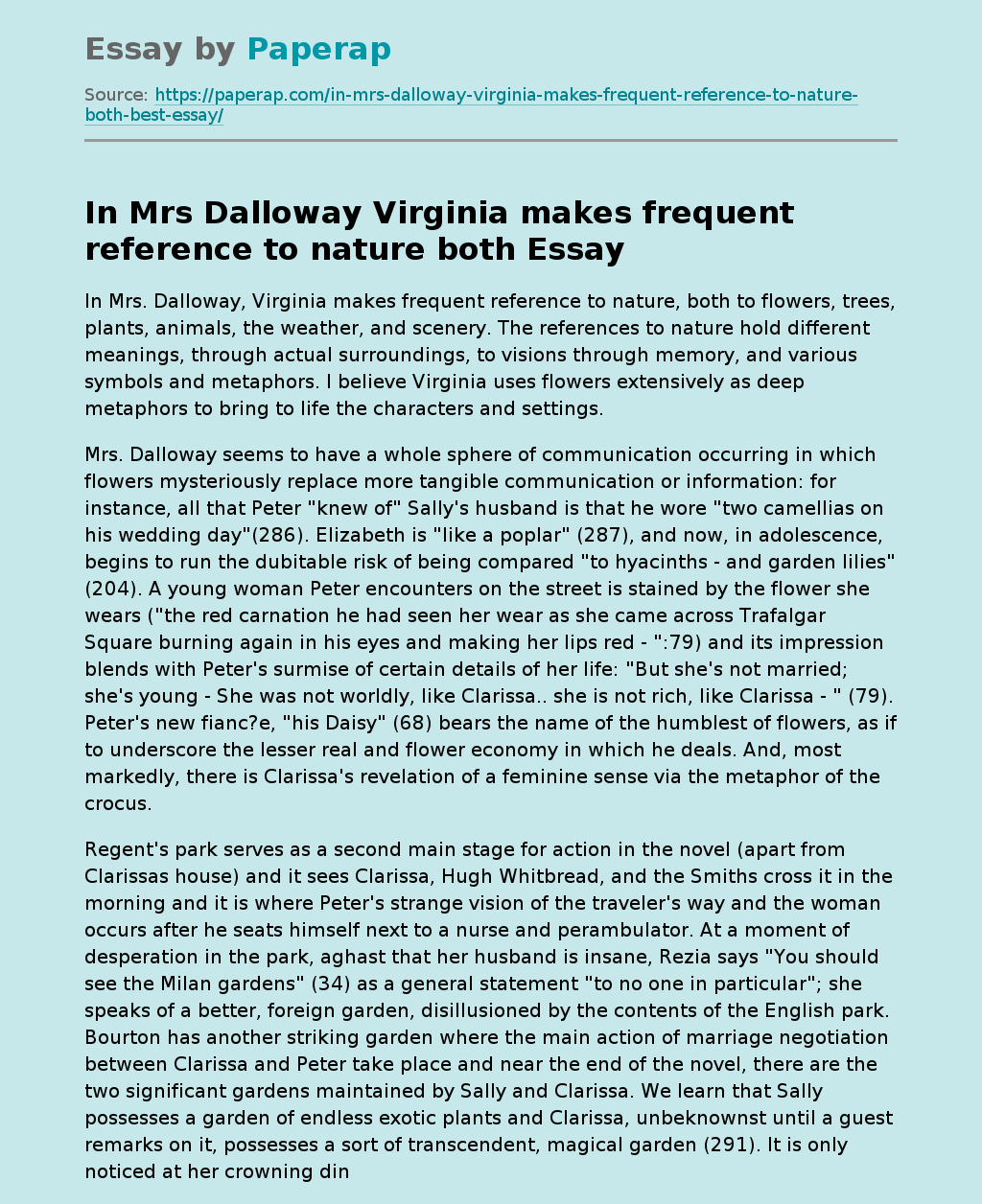In Mrs. Dalloway, Virginia makes frequent reference to nature, both to flowers, trees, plants, animals, the weather, and scenery. The references to nature hold different meanings, through actual surroundings, to visions through memory, and various symbols and metaphors. I believe Virginia uses flowers extensively as deep metaphors to bring to life the characters and settings.
Mrs. Dalloway seems to have a whole sphere of communication occurring in which flowers mysteriously replace more tangible communication or information: for instance, all that Peter “knew of” Sally’s husband is that he wore “two camellias on his wedding day”(286).
Elizabeth is “like a poplar” (287), and now, in adolescence, begins to run the dubitable risk of being compared “to hyacinths – and garden lilies” (204). A young woman Peter encounters on the street is stained by the flower she wears (“the red carnation he had seen her wear as she came across Trafalgar Square burning again in his eyes and making her lips red – “:79) and its impression blends with Peter’s surmise of certain details of her life: “But she’s not married; she’s young – She was not worldly, like Clarissa.
. she is not rich, like Clarissa – ” (79). Peter’s new fianc?e, “his Daisy” (68) bears the name of the humblest of flowers, as if to underscore the lesser real and flower economy in which he deals. And, most markedly, there is Clarissa’s revelation of a feminine sense via the metaphor of the crocus.
Regent’s park serves as a second main stage for action in the novel (apart from Clarissas house) and it sees Clarissa, Hugh Whitbread, and the Smiths cross it in the morning and it is where Peter’s strange vision of the traveler’s way and the woman occurs after he seats himself next to a nurse and perambulator.
At a moment of desperation in the park, aghast that her husband is insane, Rezia says “You should see the Milan gardens” (34) as a general statement “to no one in particular”; she speaks of a better, foreign garden, disillusioned by the contents of the English park. Bourton has another striking garden where the main action of marriage negotiation between Clarissa and Peter take place and near the end of the novel, there are the two significant gardens maintained by Sally and Clarissa. We learn that Sally possesses a garden of endless exotic plants and Clarissa, unbeknownst until a guest remarks on it, possesses a sort of transcendent, magical garden (291). It is only noticed at her crowning dinner party and is a creation by which she is declared “a magician”, a mystical artiste, as it were; surely, she is producing existential pleasures within her enclosed domain. It seems that flowers represent some sort of transcendent language that mark the artistic growth and status of the novel’s characters. Sally at first, as a young woman, plucked the heads off flowers at Bourton (Clarissa thinks: ” – wicked to treat flowers like that – “: 50). Peter, from the outset, only seems to understand or see vegetables. “I prefer men to cauliflowers” (4), he claims, not seeing or even acknowledging the flowers in Bourton’s garden, and privileging the discourse and company of men above flowers.
Clarissa, as in the opening sentence, has a consistently assertive relationship to flowers; she peers out onto the world over her “arms full of sweet peas”(21), and Sally’s main image of her at Bourton is “Clarissa all in white – with her hands full of flowers” (287). And, that her husband Richard understands this by his silent but meaningful gift of roses (179). Sally too, in her marriage and gardening that came with adulthood, seems learned the language of plants: ” – she often got from her flowers a peace which men and women never gave her” (294). Indeed, in her maturity, for Sally “Bourton is tobacco” (287). She uses a plant-metaphor for the sleepless nights, political debates, and youthful challenges to authority that occurred there in their youth: she has become greatly articulate in the symbolic language of plants.
We can see why Woolf might be attracted to flowers as a metaphor for artistic or psychological sublimation, as they are both androgynous and sexual, unlike the mere “cabbages” that Peter is fixated upon, and ephemerally beautiful, like the realm of consciousness.
Clarissa’s creative victory as hostess in rooms over which she presides, in which is achieved an overcoming of seeming opposites and her personal and interior space is validated by a social world: in this particular scene, there seems to occur a harmonious discourse of flowers and men, such that neither minds the other. Clarissa Dalloway remains a model of thankful sanity (because of Richard, calmly sitting there reading the Times: 281) and balance, while the character of Septimus has an irrecoverably fractured internal personal space. He must loosely and wildly wander through a public park, in which his wife sees no great beauty or merit. It is only in the walls of his own home that experiences some moments of peace achieved here in his personal space, after which he can make the decision to kill himself. Septimus was doomed to deal mostly in plants (trees, to be exact), and was fixated on saving them from human destruction. Just as he was never able to “understand” art or was able to master his relationship to it (or declare himself as artist), he hasn’t learned to use flowers.
In Mrs Dalloway Virginia makes frequent reference to nature both. (2019, Dec 16). Retrieved from https://paperap.com/in-mrs-dalloway-virginia-makes-frequent-reference-to-nature-both-best-essay/

